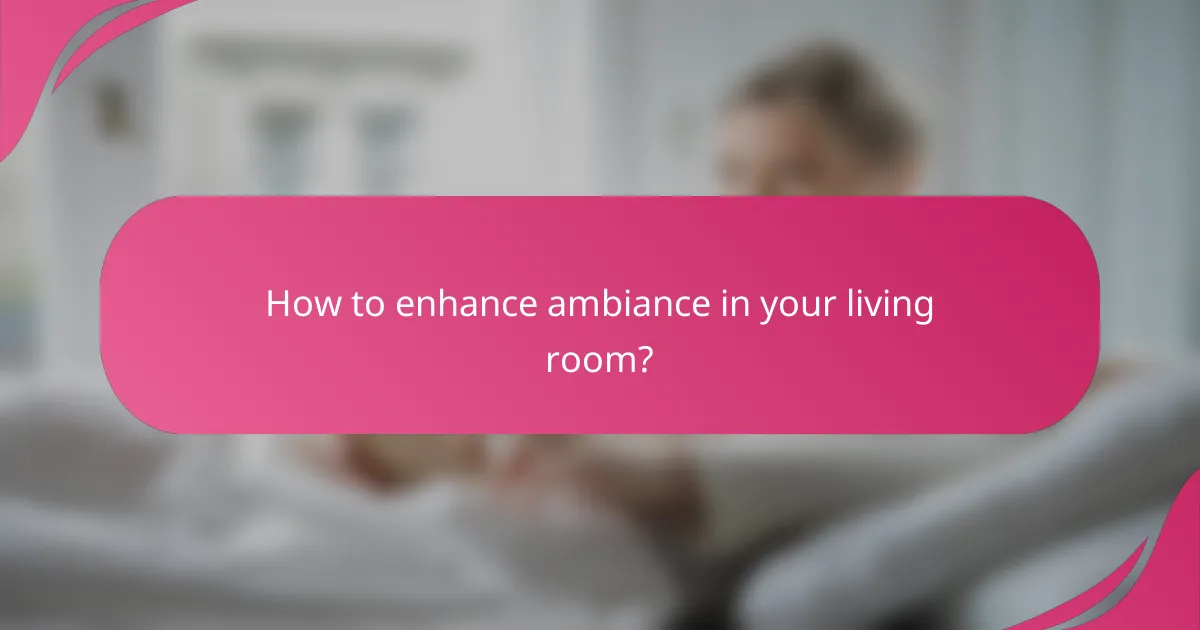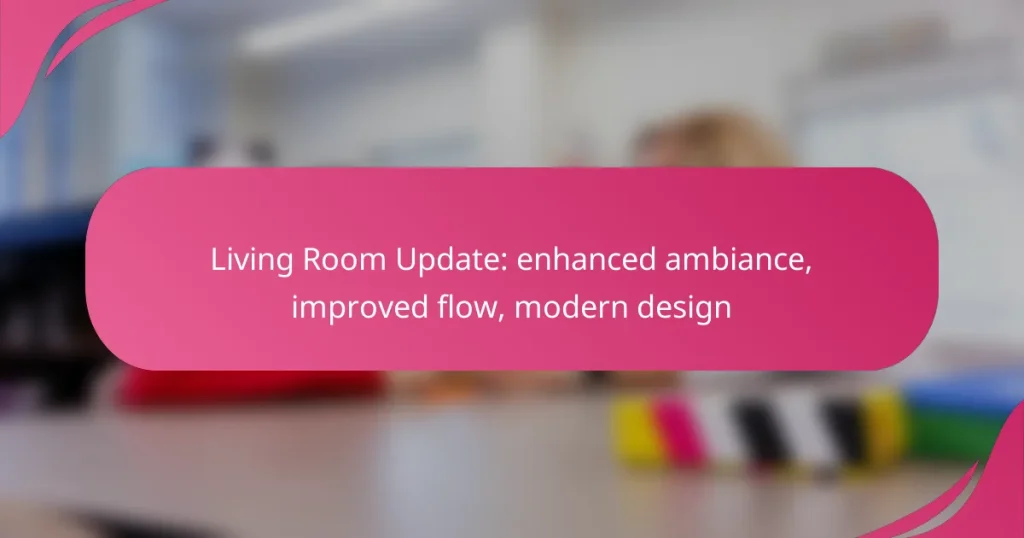Updating your living room can significantly enhance its ambiance and improve the flow of the space. By incorporating modern design elements such as minimalist furniture, strategic lighting, and thoughtful arrangements, you can create a warm and inviting atmosphere that promotes interaction and functionality. Embrace contemporary trends to achieve a cohesive look that reflects your personal style while ensuring a seamless experience for both residents and guests.

How to enhance ambiance in your living room?
Enhancing the ambiance in your living room involves creating a warm, inviting atmosphere through thoughtful design choices. Focus on lighting, color, texture, and greenery to achieve a modern and cohesive look.
Layered lighting techniques
Layered lighting combines ambient, task, and accent lighting to create depth and warmth. Use ceiling fixtures for general illumination, table lamps for reading, and wall sconces or LED strips to highlight artwork or architectural features.
Consider dimmable options to adjust brightness according to the time of day or mood. A mix of warm and cool light sources can also enhance the overall feel of the space.
Color palette selection
Selecting a cohesive color palette is crucial for a modern living room. Aim for a balance of neutral tones with pops of color that reflect your personality. Soft grays, whites, and beiges can serve as a backdrop, while vibrant cushions or artwork add character.
Limit your palette to three or four main colors to avoid visual clutter. Use color swatches to visualize how different shades interact in your space before making final decisions.
Textural contrasts
Incorporating various textures adds depth and interest to your living room. Mix materials like soft fabrics, smooth metals, and natural woods to create a dynamic environment. For instance, pair a plush velvet sofa with a sleek glass coffee table.
Consider layering rugs or using throw pillows in different fabrics to enhance comfort and visual appeal. This contrast can make the space feel more inviting and sophisticated.
Incorporating plants
Plants are an excellent way to enhance the ambiance of your living room by adding life and color. Choose low-maintenance varieties like snake plants or pothos, which thrive in various lighting conditions.
Position plants at different heights using stands or shelves to create visual interest. Grouping plants together can also form a mini indoor garden, making the space feel more vibrant and fresh.
Decorative accessories
Decorative accessories, such as artwork, vases, and books, can personalize your living room and enhance its ambiance. Choose pieces that resonate with your style and complement your color palette.
Be mindful of scale and arrangement; larger pieces can serve as focal points, while smaller items can be grouped for impact. Regularly update these accessories to keep the space feeling fresh and aligned with seasonal changes.

What are the best modern design trends for living rooms in Canada?
The best modern design trends for living rooms in Canada focus on creating a functional yet stylish space that enhances ambiance and flow. Key trends include minimalist furniture, open floor plans, smart home integration, and bold accent walls, all of which contribute to a contemporary aesthetic.
Minimalist furniture styles
Minimalist furniture styles emphasize simplicity and functionality, often featuring clean lines and neutral colors. In Canada, this trend is popular for its ability to create a spacious feel in living rooms, making them appear larger and more inviting.
When selecting minimalist furniture, consider pieces that serve multiple purposes, such as a coffee table with storage or a sofa bed. This approach not only maximizes space but also reduces clutter, which is essential for maintaining a modern look.
Open floor plans
Open floor plans are a hallmark of modern living room design, promoting a seamless flow between spaces. This layout allows for better natural light distribution and encourages social interaction, making it ideal for both family gatherings and entertaining guests.
To achieve an open floor plan, consider removing non-load-bearing walls or using furniture to define different areas. Ensure that the design maintains a cohesive style throughout the space, using similar colors and materials to create harmony.
Smart home integration
Smart home integration is increasingly popular in Canadian living rooms, enhancing convenience and energy efficiency. This trend includes the use of smart lighting, thermostats, and entertainment systems that can be controlled via smartphones or voice commands.
When incorporating smart technology, prioritize devices that are user-friendly and compatible with existing systems. Consider starting with smart bulbs or a smart speaker, which can easily be integrated without major renovations.
Bold accent walls
Bold accent walls add personality and depth to modern living rooms, allowing homeowners to express their style. In Canada, popular choices for accent wall colors include deep blues, rich greens, and vibrant reds, which can create a striking focal point.
To create an effective accent wall, choose a wall that naturally draws attention, such as the one behind the sofa or a fireplace. Use paint, wallpaper, or even wood paneling to achieve the desired effect, ensuring it complements the overall design of the room.

How can you improve flow in your living room?
Improving flow in your living room involves arranging furniture and defining spaces to promote movement and interaction. By strategically placing items and using design elements, you can create a more inviting and functional environment.
Furniture arrangement strategies
To enhance flow, consider the arrangement of your furniture. Aim for a layout that encourages conversation and easy movement, typically with seating facing each other. Avoid blocking pathways with large pieces; instead, opt for smaller, modular furniture that can be easily rearranged.
Use the 80/20 rule: 80% of your space should be open for movement, while 20% can be occupied by furniture. This balance helps maintain a spacious feel while providing comfort.
Defining zones with rugs
Rugs can effectively define different areas within your living room, such as a seating zone or a reading nook. Choose rugs that are large enough to fit under the front legs of your furniture to create a cohesive look.
Consider using contrasting colors or patterns to visually separate zones while maintaining a harmonious overall design. This technique not only enhances flow but also adds visual interest to the space.
Creating pathways
Establishing clear pathways is crucial for improving flow in your living room. Ensure there is at least 24 to 36 inches of clearance for walkways to allow comfortable movement. This is especially important if the room is frequently used for gatherings.
Use furniture placement to guide movement naturally. For example, arrange seating in a way that directs guests towards the main focal point, such as a fireplace or television, while keeping pathways unobstructed. Avoid cluttering these areas with decorative items to maintain an open feel.

What are the key criteria for selecting living room furniture?
When selecting living room furniture, prioritize functionality, comfort, size, and material durability. These criteria ensure that your space is not only aesthetically pleasing but also practical and long-lasting.
Functionality and comfort
Furniture should serve a purpose while providing comfort. Consider how each piece will be used; for example, a sofa should be inviting for lounging or entertaining. Look for ergonomic designs that support good posture and relaxation.
Test seating options in-store or through samples to ensure they meet your comfort needs. Pay attention to cushion firmness and back support, as these factors significantly impact your overall experience.
Size and scale considerations
Choosing the right size and scale of furniture is crucial for maintaining a balanced living room layout. Measure your space and consider the dimensions of each piece to avoid overcrowding. A general rule is to leave at least 30 inches of walking space between furniture items.
Visualize the arrangement before purchasing by using tape to outline furniture dimensions on the floor. This helps in understanding how different pieces will fit together and ensures a harmonious flow in the room.
Material durability
The durability of materials plays a vital role in the longevity of your living room furniture. Opt for fabrics and finishes that can withstand daily use, especially if you have pets or children. Common durable materials include leather, microfiber, and high-quality wood.
Consider the maintenance requirements of different materials. For instance, while leather is easy to clean, it may require conditioning to prevent cracking. Research warranties and care instructions to make informed choices that align with your lifestyle.

What are the costs associated with a living room update?
The costs of updating a living room can vary widely based on the scope of the project, materials chosen, and labor involved. Homeowners typically spend anywhere from a few hundred to several thousand dollars, depending on whether they are making minor cosmetic changes or undertaking a complete renovation.
Budgeting for a living room update
When budgeting for a living room update, consider both materials and labor costs. For minor updates like painting or new decor, costs may range from $500 to $2,000. For more extensive renovations, such as new flooring or furniture, budgets can escalate to $5,000 or more.
It’s wise to allocate an additional 10-20% of your budget for unexpected expenses. This cushion can help cover any surprises that arise during the renovation process.
Cost-effective updates
Cost-effective updates can significantly enhance your living room’s ambiance without breaking the bank. Simple changes like repainting walls, adding new throw pillows, or rearranging furniture can refresh the space for a few hundred dollars.
Consider shopping at discount home goods stores or online marketplaces for affordable decor options. DIY projects, such as creating your own artwork or refinishing furniture, can also save money while adding a personal touch.
Factors influencing costs
Several factors can influence the overall costs of a living room update. The size of the room, the quality of materials selected, and the complexity of the design all play crucial roles. For instance, high-end finishes like hardwood flooring or custom cabinetry will significantly increase costs compared to laminate options.
Labor costs can vary based on location and the expertise of the contractors. In urban areas, labor may be more expensive, so it’s beneficial to get multiple quotes before proceeding.
Long-term value considerations
Investing in a living room update can enhance both the aesthetic appeal and functionality of your home, potentially increasing its market value. Features like open layouts, modern lighting, and energy-efficient windows can attract buyers and justify higher asking prices.
When planning your update, focus on timeless designs and quality materials that will stand the test of time. This approach not only improves your living space but also ensures that your investment pays off in the long run.


